Maya architecture has three regional styles. Jim O’Kon, a specialist in Maya engineering, and technology encounters a range of exotic animals in deepest rainforest while finding the style of the Ruta Rio Bec.
Driving across Mexico’s Yucatan Peninsula and traversing the Maya cities on the Ruta Rio Bec is a voyage brimming with ancient history blended into the experience of traversing a jewel of a rainforest. The magnificent Maya ruins constructed in the Rio Bec regional style are situated in the midst of a Biosphere Reserve that is home to exotic species of fauna including monkeys, jaguars, crocodiles, toucans, macaws, parrots, wild boars, tapirs and dangerous snakes.
The jungle route affords the traveller the opportunity to view an incredible array of towering rainforest trees, a variety of exotic carnivorous plants, orchids of different species and myriads of insects. As you traverse the Maya sites it seems as though you are alone in the jungle and entering a state of suspended time. On the Ruta Rio Bec you will find yourself in mysterious places, zones of lost time and an enigma of otherworldly design.
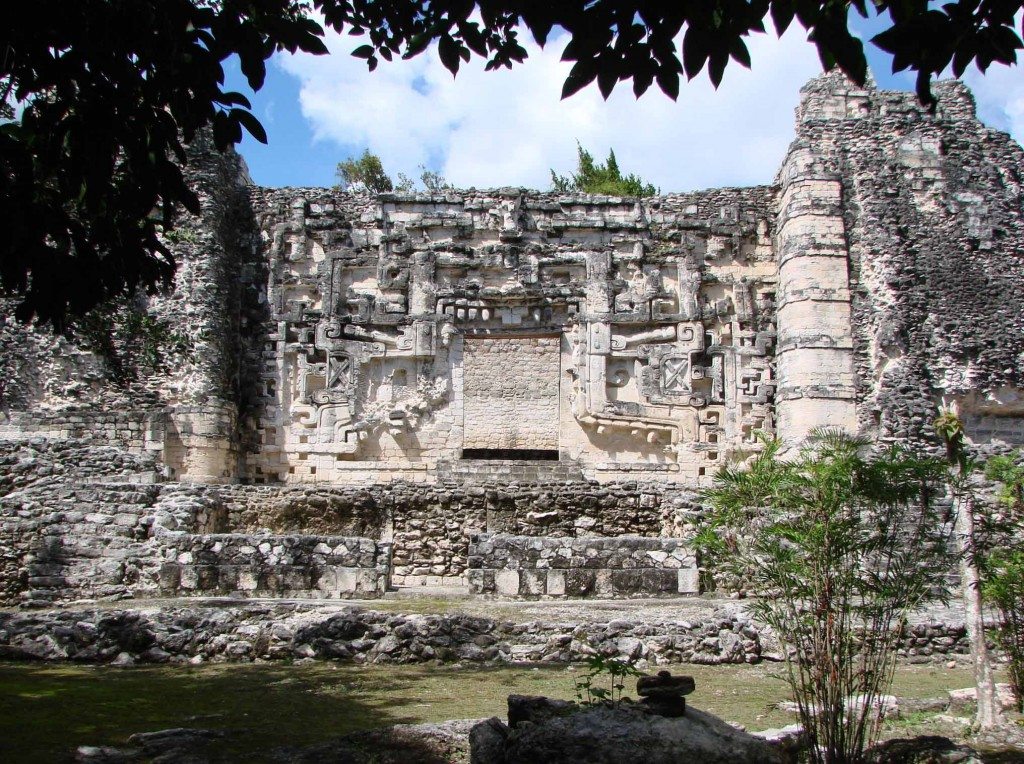
Hormiguero Structure. Photo © Jim O’Kon.
The Rio Bec style
The regional architectural styles of the Maya include the Rio Bec, classic Puuc and Chenes styles. These styles are reflected in the design of the art and architecture that compose the magnificent structures located in ancient Maya cities. The Rio Bec style, with its mysterious and enigmatic designs found a special niche in the Maya philosophy of art and architecture.
Little is known about the secrets of the Rio Bec style. The monumental structures in the grand Rio Bec cities adopted this unique architectural style and the shapes and details of the buildings are enigmas of exotic design. They are spectres which materialize before your wondering eyes and will linger in your memories forever.
Temple B at Rio Bec was the subject of a 60 year search throughout the dense jungle until it was rediscovered in 1973
The cities decorated in the Rio Bec style offer a destination for pilgrims attracted by the mystical elegance of Maya artistry. The buildings exhibit examples of skilled stagecraft rather than functional design. At first glance the Rio Bec structures, carved with the typical details and decorations of a pyramid and its upper temple, appear to be actual functional buildings. You will see twin-towers that are shaped by narrowing toward the top giving an illusion of increased height that make them appear to be taller than they actually are.
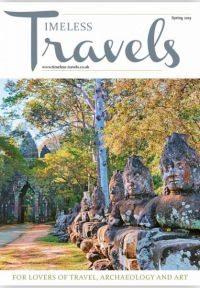
This article was originally published in Timeless Travels magazine. Republished with permission.
Their facades feature carved stone doorways that give the appearance of entrances to interior temple rooms that don’t exist. Impossible slopes are carved in stone on the face of structures and stairs leading to the top that are not made to go up or down.
The Rio Bec style produced enigmatic temples and pyramids soaring above the rainforest that present no apparent purpose or function. The carved details, scrupulously preserved, present the vital and inseparable symbolic elements that shape the exterior appearance of the temple-pyramid.
Ruta Rio Bec is sited along a stretch of highway north of the Mexican and Guatemala border. The drive can be done in a day, but it is better to take your time enjoying Maya culture and history. The Maya cities in the Rio Bec region include Rio Bec, Xpujil, Becan, Chicanna, and Hormiguero. The ceremonial centres are grouped in close proximity. A base of operations in the village of Xpujil makes all the sites readily accessible.
Rio Bec
The ancient city of Rio Bec is a well preserved late classic ceremonial site secluded in dense rainforest. The road to the site is long and sometimes impassable but the effort to visit is worth the difficulty. The Rio Bec architectural style first appeared at Rio Bec and subsequently spread to other nearby sites.
Rio Bec was first discovered in 1912 by Dr Raymond Merwin and Clarence Hay and then subsequently ‘lost’ in the annals of Maya history. Temple B, the quintessential structure at Rio Bec, was the subject of a 60 year search throughout the dense jungle until it was rediscovered in 1973 by Hugh and Suzanne Johnston. Temple B, the most important building at Rio Bec, is significant in Maya history because its design characteristics serve as the basis for the Rio Bec architectural style.
The temples are characterized by a unique architectural style that began to appear during the seventh century AD and continued into the early twelfth century AD. The temple-pyramids consist of a range type building with typically two non-functional solid masonry towers located on both ends of the acropolis. The mysterious symbolic details carved into the stonework of the structure form the basis of the Rio Bec style.
Chicanna
The site is near the main highway and is easy to reach. Arrival at the site places the visitor deep in the rainforest. Touring the site engulfs the visitor in a tunnel formed by the dense rainforest canopy.
Chicanna was built between 600 and 800 BCE. The name Chicanna means House of the Serpent Mouth in the Mayan language. The site received the name Chicanna because of an ornately carved doorway constructed to look like a large monster mouth. Elaborate stone architecture, pyramids and temples with incredible details are located around the site, which at 14 square miles is the largest of the Rio Bec cities.
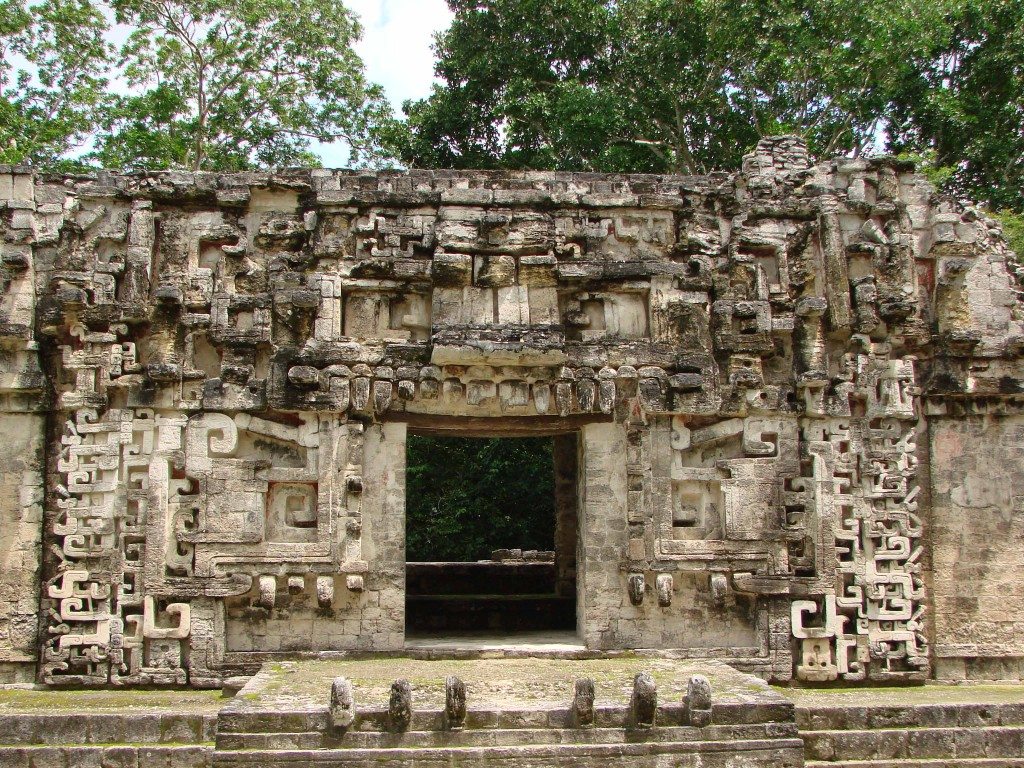
Chicana Structure with Mask. Photo © Jim O’Kon.
Archaeologists stress the great beauty of Structure II, which is richly decorated with a huge mask of Itzamná, God the Creator. The mosaic of carved stone elements forms a fantastic work of art representing the face of Itzamná on the façade of the structure. The complex mosaic was stuccoed and painted with beautiful colours. The remains of red and blue stucco colours and red painted glyphs decorate the façade which is considered the most beautiful example of art within the area of the Rio Bec architectural style.
The pyramid at the site is topped by a tower that is articulated in carved stone details in the Rio Bec style. However, this structure has a small room at the summit and the doors are actually functional.
Chicanna is truly a mystical site with its humid rainforest canopy and the exotic architecture that lends an air of mystery to the beauty of the site.
Xpuhil
The site of Xpuhil features towering pyramids sited on a high point overlooking the land to the north. The site is visible from the main road, and is quite accessible. The three towers forming the main structure rise high above the elevated site.
Xpuhil is the Maya name for the aquatic plant known as the ‘cat tail’. The site was one of the ‘lost’ Rio Bec cities discovered in the early 19th century: lost and rediscovered in the 1930s.
The main structure at Xpuhil is Structure I which has three concrete faux towers, instead of the typical two towers found in most examples of Rio Bec buildings. The towers are built in tiers, with rounded corners and all have a ‘false’ staircase carved in the facade. The structure is crowned by a temple with doorways flanked by stone mosaics of large earth monster heads with open jaws.
Although Xpuhil is a small site, it is certainly worth the visit because of the drama of the main structure.
Becan
Visiting the Maya city of Becan is a short side trip, since it is located close to the main highway. The site of Becan is unique in the annals of Maya cities, because it is a fortified city surrounded by a defensive moat. Becan means ‘trench’ in Maya, and this feature gave the city its name.
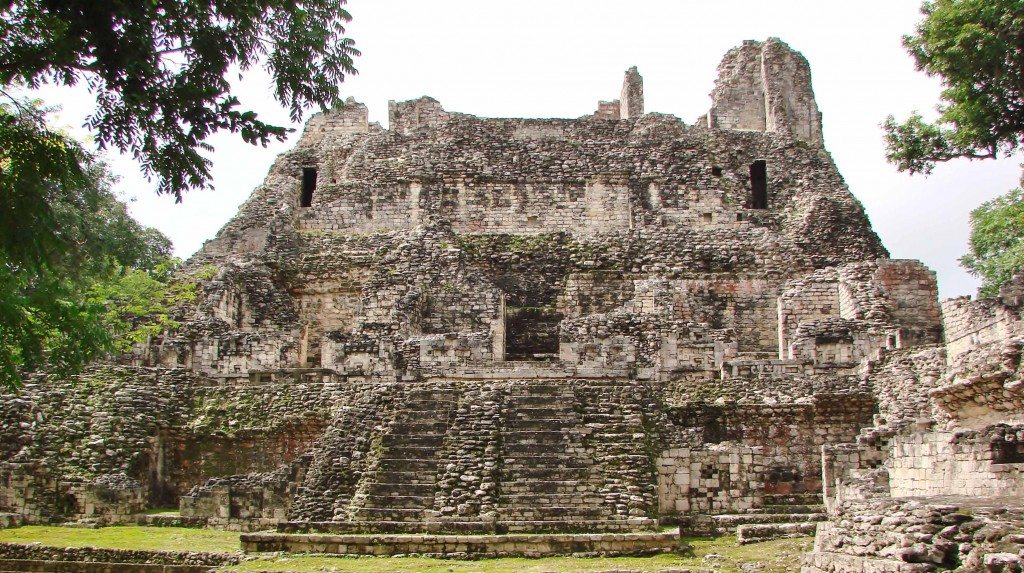
Becan Temple.Photo © Jim O’Kon.
Becan was a powerful city, the home of approximately 60,000 people. It is considered to be the capital of the Rio Bec region. The encircling moat, that is 2 km in length, surrounds the city civic and ceremonial centre. The moat is crossed by seven bridges and served as a defensive measure and a water supply system.
Occupied around 550 BCE, it flourished from 600 AD to 900 AD. Trade items from Teotihuacan in central Mexico have been found here providing evidence that the site was used as a commercial trading centre.
A tour of the site inside the confines of the moat offers the viewing of a number of monumental buildings. A series of pyramids and temples in the Rio Bec style are in the compound. Outstanding examples of buildings include the tallest structure-pyramid at the site. The structure is over 170 feet tall, with a carved temple on the summit. It is believed to be a temple dedicated to death.
Another outstanding example of Maya architecture is a Palace with a pyramid front and a façade composed of a stone carved mosaic of a monster mouth. The monster mouth is the entrance to the temple. The top of the temple supports a roof comb.
There is a covered passage of over 200 feet long leading from the palace district to the residential and the ritual area with its pyramids and ball courts. Discovered in 1937, excavations in 1971 were sponsored by the Tulane University and National Geographic Society.
Hormiguero
The site of Hormiguero is easily accessible; it is located 22 km south of the village of Xpuhil. The name Hormiguero means ‘Ant Hill’ in the Mayan language. The site contains the best preserved examples of Rio Bec architecture of all the sites and includes the remarkable symbolic detail that is part of the sculptural artistry of the style.
The structures are massive as they rise 150 feet high above the ground and are surrounded by jungle.
One of the outstanding structures on the site is Structure II; it is located at the top of a platform, it has an elaborate sculpted motive in its main façade, constructed in the Rio Bec architectural style, and it has two false towers with a staircase framed by an impressive carved stone mosaic in the form of a giant monster door. The mask is replete with elaborate stucco work that is in excellent condition.
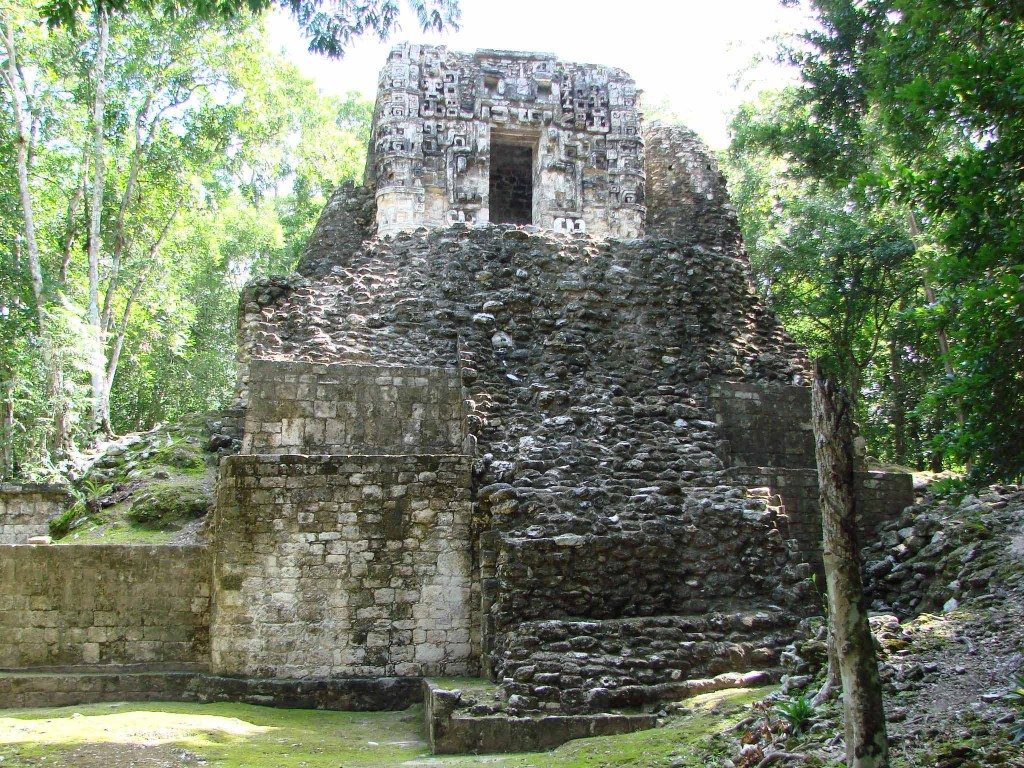
Hormiguero Structure V. Photo © Jim O’Kon.
Structure V is a singular building located to the rear of the site. The monument is a tall pyramid that includes a single chamber with a stone façade decorated by a mosaic mask. The site includes large ornate temples and ceremonial structures that adhere to the Rio Bec style.
The dichotomy of the Rio Bec style of architecture seems to evoke extreme and opposite reactions from scholars, some favourable and others not so favourable. Dr Michael Coe, the eminent archaeological scholar, referred to the design of the Rio Bec towers as an ‘aberrant architectural style’. He considers the Rio Bec architects ‘to have been misguided and chose the easy way out in constructing their pyramid towers. They choose staged theatrical decoration rather than actual functional buildings to create their grand cities’.
To today’s ‘functionalists’, the fakery of the Rio Bec style is somewhat repellent, but no one could help but be awed by the artistry of these mysterious sites crumbling in their jungle fastness.”
In contrast, archaeologist Paul Gendropis is more sympathetic and upbeat about the Rio Bec style, ‘The style is something that might pass for a simple, decadent copy without any utilitarian value but styled with theatrical imagery. Analysing these buildings, so characteristic of the Río Bec area, relates to the important place they occupy at each site, the detail and excellence of their execution, the peculiarities of their architectural conception, the systematic and coherent use of a series of distinctive traits, and the importance itself of the iconographic motifs used’.
From functional uselessness to complete suppression was merely a step, and this is what probably took place in the ceremonial centres of Rio Bec, where the only thing preserved, though scrupulously, was the exterior appearance of the temple-pyramid with its vital and inseparable addition of symbolic elements.
The memories of travellers that are exposed to the other worldly design of the Rio Bec style will last now and forever. The mind and body of the visitant will be completely encompassed by the air of artistic mastery and the ambiance of the humid rainforest that will leave one with memories for a lifetime.
About the Author
 James A O’Kon, P.E. is a professional engineer with decades of experience designing award winning projects. He a graduate of Georgia Tech with graduate degrees from NYU He has spent forty years investigating Maya engineering feats and lost Maya technology. His interest in archaeological history began while playing in Civil War battlefields near his boyhood home in Atlanta, Georgia.
James A O’Kon, P.E. is a professional engineer with decades of experience designing award winning projects. He a graduate of Georgia Tech with graduate degrees from NYU He has spent forty years investigating Maya engineering feats and lost Maya technology. His interest in archaeological history began while playing in Civil War battlefields near his boyhood home in Atlanta, Georgia.
His investigation of Maya technology has carried him to more than 50 remote Maya sites collecting data and discovering lost technology that allowed the Maya civilization to prosper in a fickle environment. His exploration of the lost cities, collection of data, analysis of data using digital tools and computer reconstruction of Maya technology led to the revelation of lost Maya technology, He has delivered numerous scientific papers to scientific symposia dealing with Maya technology. He was inducted into the Explorers Club as a National Fellow for his work on Maya technology.
He is the author of the bestselling book: Lost secrets of Maya Technology. The book uncovers the amazing technological achievements of the Maya civilization. He currently consults as an expert witness in construction failures, and as a problem solving consultant to global corporations when he is not in the rainforest investigating.
